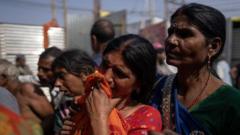Recent concerts in India have highlighted significant venue-related challenges, as attendees express frustration over poor sanitation and traffic issues despite the booming live music industry.
Concertgoers Demand Better Facilities Amid India's Growing Live Music Scene

Concertgoers Demand Better Facilities Amid India's Growing Live Music Scene
Indian fans urge improved sanitation and crowd management at concerts, stressing the need for better venue infrastructure.
As India's concert industry continues to expand, fans are becoming increasingly vocal about inadequate facilities at major events. Numerous complaints have emerged following Punjabi pop star Diljit Dosanjh's recent performance in Chandigarh, where attendees like Amrita Kaur encountered unsatisfactory sanitation conditions, minimal crowd control, and overwhelming traffic congestion. Kaur likened the experience to a gamble, particularly when using the restroom at a venue that lacked proper hygiene.
With the concert scene steadily gaining momentum—last year generating roughly 8 billion rupees ($94.1m)—more than 400,000 fans traveled for live performances. Yet, many are disheartened by the experience, often feeling that exorbitant ticket prices do not equate to satisfactory facilities. A distraught diabetic fan even reported a troubling incident at a Bryan Adams concert due to a lack of restroom access.
The frustrations have led to social media outcries, prompting Dosanjh to declare that he wouldn't perform in India until venue standards improved, a comment he later clarified referred to specific locations. His sentiments resonated with other concertgoers who criticized their experiences, such as long traffic waits and high ticket prices leading to inadequate services.
The absence of dedicated concert venues exacerbates the situation. Organizers like Anmol Kukreja of Skillbox note that many concerts are held in less than ideal locations—malls or public lands—each presenting unique issues, including improvisation regarding sanitation. While public stadiums offer larger spaces, they often suffer from poor acoustics and complicated management processes.
Thus, to alleviate challenges, concert promoters often invest heavily in temporary infrastructure, which can lead to financial strain. Not only does this situation affect major international acts, but it also sidelines smaller artists who fail to draw significant crowds.
Concerns about high ticket prices as exclusivity increases have sparked debates on accessibility as well. Concertgoers are frustrated with the lack of provisions for people with disabilities, revealing a troubling gap in inclusivity.
Despite these grievances, the allure of live performances remains strong among young people. Many fans believe that the excitement of large crowds overshadows the inconveniences. Yet, as criticism mounts regarding the standard of facilities at events, the sustainability of this thriving industry could be at risk.
The pressure for improvement intensifies as major artists prepare for their tours in India. Attendees are hopeful for a better experience than what has been afforded to them thus far, with many reiterating that it is essential that venues rise to meet these growing demands.




















